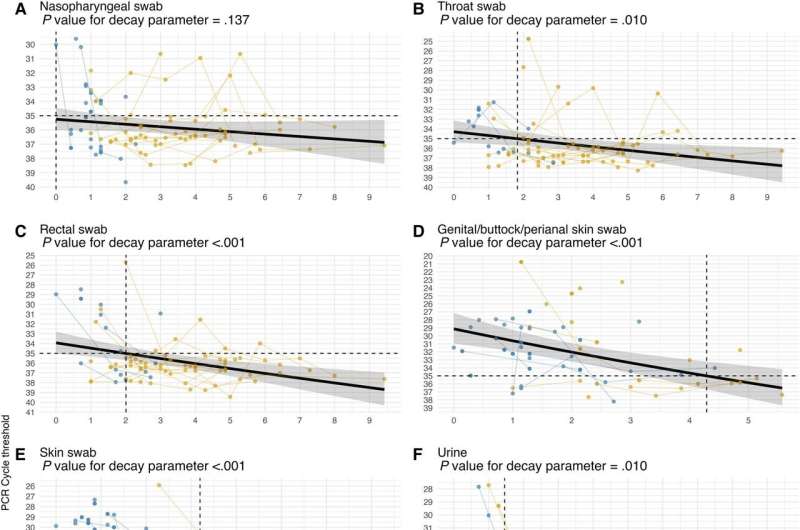This article has been reviewed according to Science X's editorial process and policies. Editors have highlighted the following attributes while ensuring the content's credibility:
fact-checked
trusted source
proofread
Study finds mpox DNA can persist in the body for up to four weeks

DNA from the mpox virus can be found in different parts of the body for up to four weeks after symptom onset, according to a study led by researchers at Unity Health Toronto, the Sunnybrook Research Institute and the University of Toronto.
The researchers analyzed samples from 64 men who contracted mpox, including participants from the Mpox Prospective Observational Cohort Study led by Darrell Tan, an infectious disease physician at St. Michael's Hospital, part of Unity Health Toronto—where some of Toronto's first patients with mpox were identified and cared for—and associate professor in the department of medicine and the Institute of Medical Science at U of T's Temerty Faculty of Medicine and in the Institute of Health Policy, Management and Evaluation (IHPME) at the Dalla Lana School of Public Health.
They found that persistence of mpox virus DNA varied depending on where the samples were taken from. Among the key findings was that the DNA was detectable in nearly half of genital skin swabs and one in five skin swabs from other sites a week after symptoms had resolved.
The study, which was published in Open Forum Infectious Diseases, is one of several projects supported by the mpox rapid research response launched by the Emerging and Pandemic Infections Consortium (EPIC), an institutional strategic initiative, and its hospital partners during the global outbreak of mpox—previously known as monkeypox—in 2022.
According to the World Health Organization, nearly 94,000 confirmed cases of mpox, including 179 deaths, have been reported from 117 countries since January 2022. As of September 2023, 1,515 cases have been confirmed in Canada, mostly in Ontario and Quebec.
"Even though we've known about mpox for over 70 years, it was new to us because we hadn't seen it outside the endemic regions," said Robert Kozak, one of the study's authors and a clinical microbiologist at Sunnybrook Research Institute and assistant professor in the department of laboratory medicine and pathobiology at Temerty Medicine. "There was still a lot about the virus and disease that we didn't know,"
To answer key questions about viral shedding, Kozak teamed up with Tan and Sharmistha Mishra, an infectious disease physician at St. Michael's Hospital and associate professor in the Temerty Faculty of Medicine's department of medicine and Institute of Medical Science and IHPME.
The researchers used a technique called quantitative polymerase chain reaction (qPCR) to determine the persistence of mpox virus DNA. Samples were taken from six different sites on the body—genital region, nasal cavity, semen, skin, throat and urine—and over an extended period of time.
On average, mpox DNA was detected in skin swabs from the genital and perianal region and from other skin sites at 30 and 22 days after symptom onset, respectively. These findings are consistent with the sexually transmitted nature of mpox during the recent global epidemic, which primarily affected gay and bisexual men as well as men who have sex with men.
The researchers were unable to detect viral DNA in a large proportion of semen samples and nasal cavity swabs taken when individuals first presented with symptoms, whereas in urine and throat swab samples, mpox DNA persisted for roughly two weeks after symptom onset.
Interestingly, the researchers did not observe a difference in the length of viral DNA persistence between people who received the antiviral drug tecovirimat and those who did not. Tan noted that while study participants were not randomly assigned to receive the drug, these results underscore the uncertainty around tecovirimat's effectiveness in treating mpox infections.
He added the study provides several key learnings for his clinical colleagues. "First, we've documented the breadth of clinical samples in which mpox DNA can be identified and therefore can be used to confirm a diagnosis. Our findings also reinforce that it's worthwhile for clinicians to collect such samples in individuals where an mpox diagnosis is being considered, even after symptoms of feeling unwell are gone," Tan said.
The researchers caution that just because mpox DNA can be detected up to four weeks after symptom onset, it doesn't mean that individuals are infectious for that long.
"We don't know for sure whether the presence of detectable viral DNA necessarily means that the virus is transmissible to other people, so more research definitely needs to be done to determine definitively the period of infectiousness," Tan said.
To that end, Jacklyn Hurst, a postdoctoral fellow in Kozak's lab, recently started work in the Toronto High Containment Facility to look for live virus in the same samples from which mpox DNA was detected. The researchers are also using the facility's biobank of mpox patient samples to identify biomarkers that could predict whether a person will have a mild or severe infection.
"Without the Toronto High Containment Facility, we wouldn't be able to do any of this. Having that facility will help us answer a lot of questions about this virus and how to stop it," said Kozak.
He acknowledged the immense contributions of the patient community to this work. "A huge thank you to all the study participants. We wouldn't be able to do this work without their sacrifice and commitment."
More information: Darrell H S Tan et al, Longitudinal Analysis of Mpox Virus DNA Detectability From Multiple Specimen Types During Acute Illness: A Cohort Study, Open Forum Infectious Diseases (2024). DOI: 10.1093/ofid/ofae073




















